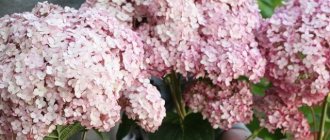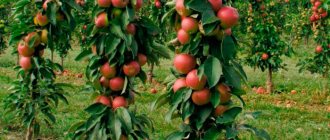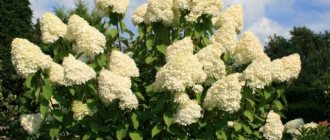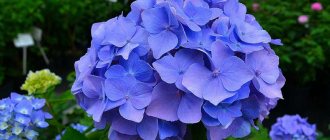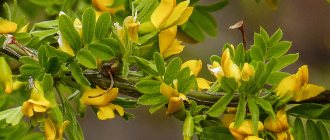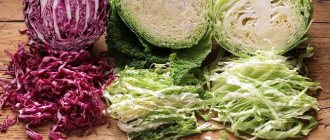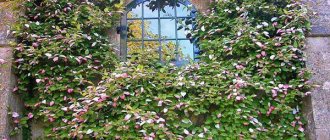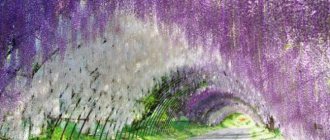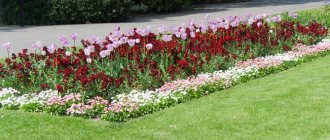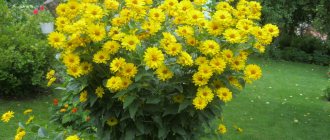Tree hydrangeas are large, tall shrubs with lush white inflorescences. They differ from other species of the family in the specifics of cultivation and care. Rounded bushes are good in summer cottages, in landscape compositions and green hedges. We tell you what they are and what their features are!
general information
Tree hydrangea is one of the types of garden hydrangea that came to us from the East and Sakhalin. Some varieties come from North America and naturally grow up to 3-4 m. In the garden they usually grow only up to 1-2 m and are used as ornamental shrubs.
A lush, voluminous bush is formed by thin, pubescent shoots with oval or ovoid leaves. The plates are large, up to 20 cm, and bright green, against which the snow-white caps of the inflorescences look even more impressive. Long thin petioles radiate from the stem opposite each other - this is called opposite growth.
Unlike paniculate hydrangea, tree hydrangea has corymbose inflorescences up to 15 cm in size. They are formed by relatively small white flowers up to 1.5-2 cm in diameter. The flowering is very lush and abundant, and lasts from mid-summer until the first October cold.
Reproduction methods
Hydrangea propagation in culture is carried out vegetatively. Convenient and quick options are cuttings, division and layering.
Read more about how to grow hydrangea from seeds.
The seed method is not suitable for a couple of reasons:
- firstly, the flowers of most cultivated varieties are sterile, that is, they do not produce complete seed material;
- secondly, this method is time-consuming, and the grown plant will begin to bloom only after 5–6 years.
Only professionals in floriculture undertake propagation by seeds to develop new varieties.
Cuttings
Cuttings are harvested from green shoots in June or July. The branch segment should have a “heel” - a piece of bark. The shoot should also have 2 pairs of leaves and developed internodes. Material length - up to 12 cm.
Find out more about cutting hydrangea at different times of the year.
Rooting scheme:
- The cut of the cutting is soaked in “Heteroauxin” for 12 hours.
- Planted in a greenhouse in moist soil (as for seedlings). In this case, they are buried to the middle of the lower internode.
- Cover with a piece of plastic bottle.
- Once every 2-3 days, ventilate, remove condensation and water the soil. It should always be moisturized.
- In 30 days, the cutting grows small roots. You can plant rooted shoots in open ground next year.
Reproduction by layering
For layering, select the longest branch at the bottom of the bush. In the spring, perform the following actions:
- Under the layering, dig a furrow up to 4–5 cm deep.
- Place part of the shoot, cleared of foliage. Its top remains above the ground surface.
- The cuttings are secured with staples and sprinkled with soil.
- Care is carried out as for an adult bush. If the soil in the furrow sags, add fresh soil to its original state.
- Separation from the mother bush and transplantation of the cuttings is carried out the following spring.
Dividing the bush
For rejuvenation, an old hydrangea bush is divided into several parts, which also allows the crop to be propagated. The divisions are replanted in the spring, before sap flow begins.
Description of the method:
- The donor bush is dug out of the ground and carefully divided into parts.
- Each division has its own root system, shoots and foliage.
- Planting is carried out according to the rules described above for the seedling.
- Care is the same as for an adult specimen.
Varieties of tree hydrangea
In our latitudes, varieties with white flowers are most often found in gardening. Moreover, during the flowering process, the shade changes from light green and greenish to snow-white. Tree hydrangeas are also called white bush hydrangeas, and the British nicknamed them snowy hills.
Hydrangea tree Annabelle
One of the most popular varieties is notable for its very large balls of inflorescences. They are significantly larger than average and grow up to 25 cm, which is why they sometimes lie down under their own weight. Shrubs grow up to only 1.5 m, but grow up to 3 m in width.
Hydrangea arborescens Pink Annabelle
A hybrid variety based on the tree hydrangea Annabelle is also called Invincibelle. This is the first variety to come in a soft pink hue and was voted one of the best new varieties in the 2010s. If you trim the bush in time after flowering, Pink Annabelle will bloom again in six weeks.
Hydrangea tree Strong Annabelle
Another hybrid based on the Annabelle variety is notable for its resistance to external conditions. Its shoots are more powerful, and large lush inflorescences do not lie down under their own weight. This hydrangea is not afraid of heavy rains and gusts of wind.
Hydrangea tree White House
The White House variety looks interesting thanks to its delicate creamy shade. An unusual feature is the structure of the inflorescences, because fertile flowers are hidden in the middle, and large sterile ones are at the edges. The shrub grows up to 1.4 m and goes well with other species.
Hydrangea tree Bounty
Bounty is one of the most light-loving varieties, so it feels good even without midday shade. It has very small snow-white flowers, collected in a large bouquet of inflorescences.
Hydrangea tree Grandiflora
Tree-like Grandiflora is notable for its very long flowering. During this time, the flowers change color several times from light green to snow-white, and then warm cream. This is a large shrub that can grow up to 2.5-3 m, unlike its more compact counterparts.
Hydrangea tree Pink Pinkushen
One of the most unusual varieties is distinguished by the shape of its inflorescence. Here it is not spherical, but pyramidal, so this hydrangea will amazingly diversify the garden composition. Pink Pinkushen looks wonderful even when it fades.
Hydrangea tree Hayes Starburst
This is the first variety of tree hydrangea with large double flowers collected in large round inflorescences. Because of the texture of the petals, they seem even larger, although they already grow up to 25 cm with a small height of the bushes - about 1 m. Because of this, the shoots may not support the weight of the inflorescences.
Description and use of hydrangea
Due to the variety of flower colors and powerful, long-lasting flowering, hydrangea is widely used in landscape design in any area. In addition, it is quite unpretentious and grows quickly in the horizontal direction. Tree hydrangea looks great as a hedge, as a single planting or in compositions where it goes well with conifers and most large garden flowering plants.
Tree hydrangea is a fairly large shrub with a wide crown, which during flowering is completely covered with large inflorescences . The size of the inflorescences reaches thirty centimeters, the height of the bush is from one to three meters, and in open areas - up to five meters, depending on the variety.
The inflorescences consist of large sterile flowers located along the edges and small reproductive ones located in the center. Color varies from snow-white and cream to dark blue-violet tones. The decorative qualities of hydrangea are enhanced by large oval-shaped leaves. In some varieties, red pigments appear in the leaves by autumn, but most remain in bright green until winter.
Caring for tree hydrangea
Gardeners value tree hydrangea for its good winter hardiness, rapid growth, ease of rooting and abundant flowering. Modern varieties are unpretentious to soil, temperature and weather changes.
Temperature
Hydrangeas do not need any special temperature conditions outside in the garden. This is a winter-hardy plant, but in mid-latitudes and further north it is better to cover the shoots with spruce branches or a special cloth for the winter. Even if the bush freezes, it will quickly recover in the spring and bloom on schedule.
Lighting
Despite the abundant flowering, tree hydrangea does not like an excess of bright sun. To avoid burns, try to choose a place so that at noon it is in partial shade. Then the bushes grow larger and bloom more profusely.
Watering
Tree hydrangea loves moisture, so it tolerates overflow better than drought. Provide the bushes with regular watering of 15-20 liters 1-2 times a week. During rains, you can reduce the frequency so that the root system does not begin to rot.
The soil
Hydrangeas love loamy soils of medium and high acidity, but do not tolerate alkaline soil well. Before planting, use peat, compost, sod and leaf humus. Don’t forget to mulch the soil immediately after sprouting with a layer of 5-8 cm thick.
Fertilizers and fertilizing
The lushly blooming tree hydrangea loves fertilizer, so it is fed four times on a schedule. Complex nitrogen fertilizers in early spring to gain green mass, and then potassium and phosphates during the formation of buds. Distribute the remaining fertilizing evenly throughout the summer.
Transplantation and propagation
Mature powerful shrubs can be propagated by division when transplanting. Another convenient method is layering, which needs to be buried 1.5-2 cm and given support. The following year, these cuttings can be separated and replanted from the mother plant.
Hydrangea cuttings always take root, but they need to be prepared in advance - in early June or mid-summer before the shoots become lignified. Cut a stem with 2-3 pairs of leaves and treat the cut with a preparation for root growth. The rooting process in a shady place under a bottle or in a greenhouse takes up to a month.
Hydrangeas are replanted in early spring before buds appear, but seedlings from containers can be planted throughout the season. Be careful not to damage the earthen ball and root system. Immediately after transplantation, you need to prune and generously water the bush, and after 3-4 weeks, feed it.
Trimming
After planting, young plants need to be pruned and all damaged and weak shoots removed so that they grow lush and strong. For the next couple of years, do not touch the bushes and only in the fourth year, in early spring, begin to carry out formative pruning before fertilizing. You can rejuvenate old bushes by radically pruning all branches to 50 cm.
Varieties for the Moscow region
Actually, any variety of tree hydrangea can be planted near Moscow. They all spend the winter there very well. Even if the bush freezes due to a strong drop in temperature or due to icing, it will quickly recover in the spring and bloom in the same summer.
Grandiflora
The spectacular Grandiflora variety grows very quickly, even for a Tree Hydrangea. Forms a bush up to 2 m high, with a diameter of about 3 m. Convex shields 20 cm in size are first light green, then snow-white, at the end of flowering they acquire a creamy tint.
The variety is winter-hardy and grows better in good light. Does not tolerate drought. Lives in one place for 40 years. Doesn't like transfers.
Hydrangea Grandiflora has dome-shaped, irregularly shaped inflorescences
Lime Ricky
A very winter-hardy variety, suitable for planting in climate zone 3. It rarely freezes in the Moscow region. The shoots are cut short so that flowering is abundant and large scutes are formed.
Forms a neat bush with a height of 90 to 120 cm. The branches are strong, thick, and withstand bad weather well. The scutes are convex, dome-shaped, dense, and consist of sterile flowers with obovate petals. The color is lime at first, gradually becoming lighter. Flowering – July-September.
The variety grows well in any soil and is undemanding to lighting. The corymbs are often cut and used as dried flowers.
Hydrangea Lime Peaks grows well in the Moscow region
Sterilis
A fast-growing hydrangea 1.5-1.8 m high with a crown diameter of up to 2.3 m. Not as frost-resistant as many varieties, but in the Moscow region it winters without shelter. Blooms from July to September.
The scutes are dome-shaped, about 20 cm in diameter. The flowers are white, greenish before blooming. The variety prefers acidic soils and is undemanding to lighting.
Hydrangea tree Sterilis is quite tall
Pest and disease control
Most hydrangea diseases are caused by improper care and maintenance conditions. These are chlorosis, leaf burns, rotting of the root system, yellowness, leaf fall. In these cases, it is enough to adjust the regime, adjust the watering and fertilizing schedule, and create shade.
Fungal diseases are treated with special drugs - fungicides and antiseptics. To do this, you first need to get rid of damaged areas and excessive moisture. Viral ringspot has no cure, so diseased shrubs will have to be removed before the disease spreads further.
The most dangerous enemy of tree hydrangea is nematodes, which are difficult to control. Don't forget about routine preventative treatment to minimize the risk of damage. Among other parasites and pests, hydrangea is loved by slugs, aphids and spider mites, which can be eliminated mechanically and with insecticides.
Agrotechnics of cultivation
Choosing a landing site
Hydrangea Incredible tree - description, planting and care
The landing area must be illuminated. But so that the hydrangea is not exposed to the scorching rays of the sun. Otherwise, flowering will be reduced by several weeks. In the shade, hydrangea petals and inflorescences become smaller.
The place must be closed from drafts. Since the shoots become heavy during flowering and bend towards the ground, when there is a gust of wind they will fall in different directions. It won't be pretty.
Leave a distance of 2-3 meters from neighboring trees so that they do not take all the moisture.
Gardeners consider the northern side near buildings to be a suitable place.
Soil preparation
Suitable soil types are slightly acidic (pH 5.0) and acidic loams. Tree hydrangea is more tolerant of the presence of lime in the soil. Alkaline soil is generally not suitable.
To acidify the soil, add peat, pine bark, sawdust 6 months before planting.
Seedling preparation and propagation
Hydrangea propagation is carried out in several ways:
- Planting ready seedlings. Buy in early spring. An hour before planting, place the hydrangea in warm water with potassium permanganate.
- Preparation of cuttings. Carry out in the second half of June or early July in the morning. First you need to cut annual, not hardened cuttings with 2 internodes. You need to get rid of half the leaves. The lower cut is treated with a drug that stimulates root growth, for example, Kornevin. A substrate consisting of 1 part sand and 2 peat is poured into the container. The cutting is placed at an angle of 45 degrees and to a depth of 2-3 cm. All seedlings should be at a distance of 7-10 centimeters from each other. The rooting process lasts about a month. By August you can plant cuttings.
- Reproduction by layering. A lateral annual shoot is placed in a trench dug to a depth of 10 cm. The layers are secured with wire pins and sprinkled with earth. The soil around the shoot is loosened and watered. Next year in the spring you can separate the cuttings and plant them.
Disembarkation
Before the buds open, planting in open ground begins in early spring.
Hydrangea planting
Stages:
- Dig a hole 70 cm deep and 50 wide.
- The distance between several bushes is 1.5 meters, since the roots of hydrangea grow horizontally.
- The hole is filled with 1 hour of peat, 2 hours of humus, 1 hour of sand, 2 hours of chernozem.
- The seedling is taken out of the container with manganese and the roots are shortened. Remove damaged leaves and branches.
- Place the bush in the hole. The roots are straightened in different directions.
- Cover with soil. The root collar should be covered with soil no more than 3 cm.
- Compacted.
- Water generously until the soil is soaked up to half a meter.
With proper planting, flowering is observed in the 5th year.
Hydrangea care
It is necessary to water, fertilize, mulch, and trim the plant.
Top dressing
Stages:
- After planting, 2 weeks later they are fed with a mixture of urea - 20 grams, potassium sulfate - 25 g, and 40 grams of superphosphate. Fertilize annually in early spring;
- At the beginning of flowering, they are fertilized with organic and mineral substances. For example, Kemira-floral will do. You can make a mixture: superphosphate (50 grams) and potassium (40 g), added per square meter. Do not add too much nitrogen - the petals will acquire a greenish tint. The plant's resistance to frost also decreases;
- At the end of summer, rotted manure is added, 15 kilograms per square meter.
Note! All feeding is stopped before the beginning of autumn so that the branches become woody by winter.
Watering
On very hot days, hydrangea needs to be watered every two days. The soil should be soaked up to half a meter deep and 1 meter in diameter. Once a month, water with manganese solution to strengthen the branches.
Mulching
This procedure keeps the plant from overheating and helps get rid of weeds.
In the spring, peat and a mixture of compost and sawdust are added to the mulch. This will increase the acidity of the soil.
Trimming
Pruning is done annually in spring and autumn. It is carried out for the 3rd year after disembarkation.
Hydrangea pruning
Stages:
- Prevention – removal of broken and dead shoots.
- Rejuvenation – for 5-year-old plants. Remove old branches.
- Formation - last year's branches are reduced to 4 buds.
- Thinning - remove thickening bushes and non-flowering branches.
Pruning improves the shape of the bush, flowering, and adjusts the number of inflorescences.
After wilting, the flowers are cut off in the fall.
Insulation
Stages:
- Remove foliage;
- Pour sawdust under the bush;
- Place boards around the bush and attach shoots to them;
- Cover with film and sawdust.
In such conditions, hydrangea will have an attractive appearance for many years.
Tree hydrangeas - photo
Although tree hydrangea is not as diverse as its paniculate counterparts, it is still very impressive and beautiful! Not only experienced gardeners, but also amateur beginners can cope with it. If you still have doubts, take a look at our photo selection!
Planting tree hydrangea in open ground
When to plant
The planting time for tree hydrangea is chosen taking into account the climate of the area. In the north, it is better to plant it in early spring, before the sap begins to flow, as soon as the soil in the garden thaws, and in areas with a mild, warm climate, hydrangea can be planted both before the buds swell and after the leaves fall.
How to choose the right place for a plant? Hydrangeas prefer well-lit areas in the first half of the day, which are in the shade in the afternoon. Tree hydrangea does not like the wind: its flowers quickly fade in places that are blown through. The plant needs moist soil, so do not plant it close to trees and shrubs so that they do not absorb moisture intended for hydrangea from the soil: the distance from the tree hydrangea bush to any other plant should be at least 2 m.
How to plant
The best planting material is three to four year old tree hydrangea seedlings. When purchasing seedlings with an open root system, pay attention to its condition, but it is better to purchase planting material with closed roots. Before planting, water the seedling abundantly, remove it from the container and shorten its roots to 20-25 cm. If rotten or dry roots are found, you need to trim them too.
Planting hydrangea in the fall and caring for it in the garden
When planting in poor soil, a hole is dug with a diameter of about 50 and a depth of 65-70 cm, but if the soil on the site is fertile, then the depth may be less - about 50 cm. In general, the size of the hole depends on the size of the root system of the seedling and the amount of soil on it . In the center of the hole, pour a mound of pre-prepared soil mixture of humus, chernozem, sand and peat in a ratio of 2:2:1:1 with the addition of 50-60 g of complex mineral fertilizer. Place the seedling on a mound, straighten its roots and fill the remaining space with the same nutritious soil mixture. Then compact the surface of the trunk circle and water the plant generously at the root.
Propagation of tree hydrangea
Tree hydrangea propagates by cuttings, dividing the bush and layering. Professionals also use grafting and generative methods for this purpose, but for amateurs they are too labor-intensive, expensive and unreliable.
Dividing the bush
The tree hydrangea bush can be divided both in spring and autumn: the bush is dug up and taken apart in such a way that each division necessarily contains renewal buds. Plant parts of the bush in pre-prepared holes. If you carry out the procedure in the spring, by autumn parts of the bush will already take root in new places.
Reproduction by layering
This is also a fairly easy to implement propagation method that gives good results. In spring, annual shoots are bent to the ground and placed in pre-made grooves up to 10 cm deep so that the apical section, about 20 cm long, remains above the surface. The layer is fixed in this position, and the groove is filled with fertile soil. Throughout the season, the cuttings are watered and fed together with the mother plant, and in the fall or next spring it is separated from the bush and planted in a new place.
Propagation by spring and summer cuttings
This method of propagating tree hydrangea is used most often. Spring cuttings are cut in early June so that there is a heel at their base - a small part of last year's shoot. Summer cuttings are harvested in July from the apical, non-lignified part of the shoot. The cuttings should have 1-2 internodes. The upper leaves on them are shortened by half, the lower ones are removed. For successful rooting in conditions of high air humidity, you will need an installation that produces fog, and a soil mixture of two parts peat and one part sand is used as a substrate, although cuttings can also be rooted in leaf soil covered with a layer of sand 3-4 cm thick. Planting is carried out at an angle of 45º, the top of the greenhouse is covered with a transparent cap. Rooted cuttings spend the first winter in a cold greenhouse or basement, and in the spring they are planted in the ground. Next winter, the cuttings are well covered with spruce branches, and a year later they can already spend the winter without shelter.
